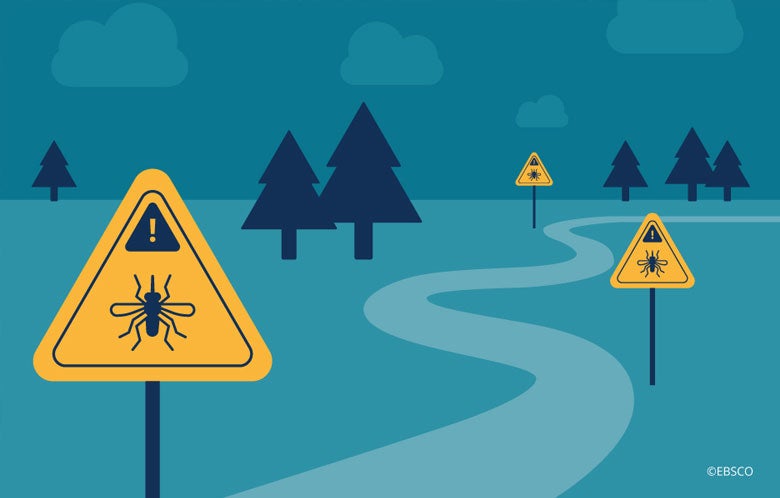Eastern Equine Encephalitis (EEE, colloquially known as “Triple E”) is a viral infection transmitted by mosquitoes. Triple E is a severe and potentially fatal disease; in cases where EEE doesn’t kill, survivors often have disabling neurologic problems. Typically, there are only a handful of cases of EEE each year, primarily restricted to the Atlantic and Gulf Coast states and Great Lakes region of the United States.
Triple E starts as a flu-like illness about a week after the infecting mosquito bite. Early symptoms are general and include fever, chills, malaise, and myalgia. Abrupt encephalitis with severe headache and disorientation can follow, and seizures and coma are possible thereafter. There is no treatment, and infection is fatal in about one-third of patients.
Preliminary diagnosis is often established in patients with a combination of clinical features, findings on brain imaging, areas of residence or travel, and local epidemiology. While laboratory diagnosis can be confirmed by detection of EEE virus-specific antibodies in cerebrospinal fluid, some patients test negative, so it’s not a useful test to rule out EEE. In fatal cases, nucleic acid amplification, histopathology, and/or virus culture of autopsy tissue can establish diagnosis post-mortem.
People who reside in or travel to areas where EEE is present — particularly those who engage in outdoor work or recreational activities — are at risk of infection in summer and early fall. In 2019, there were 38 cases of EEE in the U.S., which is the highest number of cases since 2005, when 21 cases were reported. So far in 2020, one case of EEE has been reported in Massachusetts.
Preventing mosquito bites is the most effective way to reduce the chance of EEE infection.
Preventing mosquito bites is the most effective way to reduce the chance of EEE infection.
Tracking EEE also includes testing mosquitoes and animals. Like humans, horses and occasionally other animals can become infected. Mosquito sampling allows public health officials to appropriately warn their communities and initiate mosquito control efforts such as targeted insecticide ground spraying and over-night aerial spraying. EEE-positive mosquitoes have been detected in New England, while horses with EEE have been reported across the Atlantic coast.
Interestingly, a vaccine has been developed, but it is poorly immunogenic in people and is only used for at-risk laboratory personnel. Preventing mosquito bites is the most effective way to reduce the chance of EEE infection. Recommendations from the CDC include:
- Using Environmental Protection Agency (EPA)-approved insect repellents on skin and clothing
- Wearing long-sleeved shirts and long pants while outdoors
- Taking steps to control mosquitos at home by
- Using intact screens on windows and doors
- Eliminating mosquito breeding sites (standing water)
As the U.S. enters peak transmission season for EEE, physicians in the Atlantic and Gulf Coast states and Great Lakes region should consider EEE and other arthropod encephalitides in patients with abrupt neurologic symptoms after a prodrome of flu-like illness.



